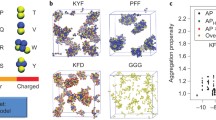Abstract
A class of peptides has been designed whose ability to self-assemble into hydrogel is dependent on their conformationally folded state. Under unfolding conditions aqueous peptide solutions are freely flowing having the viscosity of water. When folding is triggered by external stimuli, peptides adopt a β-hairpin conformation that self-assembles into a highly crosslinked network of fibrils affording mechanically rigid hydrogels. MAX 1, a 20 residue, amphiphilic hairpin self-assembles via a mechanism which entails both lateral and facial self-assembly events to form a network of fibrils whose local structure consists of a bilayer of hairpins hydrogen bonded in the direction of fibril growth. Lateral self-assembly along the long axis of the fibril is mainly facilitated by intermolecular hydrogen bonding between the strands of distinct hairpins and the formation of hydrophobic contacts between residue side chains of laterally associating hairpins. Facial assembly is driven by the hydrophobic collapse of the valine-rich faces of the amphiphilic hairpins affording a bilayer laminate. The importance of forming lateral hydrophobic contacts during hairpin self-assembly and the relative contribution these interactions have towards nano-scale morphology and material rigidity is probed via the study of: MAX1, a hairpin designed to exploit lateral hydrophobic interactions; MAX 4, a peptide with reduced ability to form these interactions; and MAX5, a control peptide. CD spectroscopy and rheological experiments suggest that the formation of lateral hydrophobic interactions aids the kinetics of assembly and contributes to the mechanical rigidity of the hydrogel. Transmission electron microscopy (TEM) shows that these interactions play an essential role in the self-assembly process leading to distinct nano-scale morphologies.








Similar content being viewed by others
References
Aggeli A, Bell M, Boden N, Keen JN, Knowles PF, McLeish TCB, Pitkeathly M, Radford SE (1997) Responsive gels formed by the spontaneous self-assembly of peptides into polymeric beta-sheet tapes. Nature 386:259–262
Badiger MV, Lele AK, Bhalerao VS, Varghese S, Mashelkar RA (1998) Molecular tailoring of thermoreversible copolymer gels: Some new mechanistic insights. J Chem Phy 109:1175–1184
Chalmers DK, Marshall GR (1995) Pro-D-NMe-Amino Acid and D-Pro-NMe-Amino Acid: simple, efficient reverse-turn constraints. J Am Chem Soc 117:5927–5937
Collier JH, Hu BH, Ruberti JW, ZhangJ, Shum P, Thompson DH, Messersmith PB (2001) Thermally and photochemically triggered self-assembly of peptide hydrogels. J Am Chem Soc 123:9463–9464
Favre M, Moehle K, Jiang L, Pfeiffer B, Robinson JA (1999) Structural mimicry of canonical conformations in antibody hypervariable loops using cyclic peptides containing a heterochiral diproline template. J Am Chem Soc 121:2679–2685
Gunasekaran K, Ramakrishnan C, Balaram P (1997) b-hairpins in proteins revisited: lessons for de novo design. Protein Eng 10:1131–1141
Holmes TC (2002) Novel peptide-based biomaterial scaffolds for tissue engineering. Trends in Biotech 20:16–21
Hutchinson EG, Thornton JM (1994) A revised set of potentials for beta-turn formation in proteins. Prot Science 3:2207–2216
Kretsinger JK, Haines LA, Ozbas B, Pochan DJ, Schneider JP (2005) Cytocompatibility of self-assembled b-hairpin peptide hydrogel surfaces. Biomaterials 26:5177–5186
Kretsinger JK, Schneider JP (2003) Design and application of basic amino acids displaying enhanced hydrophobicity. J Am Chem Soc 125:7907–7913
Lee KY, Mooney DJ (2001) Hydrogels for tissue engineering. Chem Rev 101:1869–1879
Murphy KP, Privalov PL, Gill SJ (1990) Common features of protein unfolding and dissolution of hydrophobic compounds. Science 247:559–561
Nair CM, Vijayan M, Venkatachalapathi YV, Balaram P (1979) X-ray crystal structure of pivaloyl-D-pro-L-pro-L-ala-N-methylamide; observation of a consecutive b-turn conformation. J Chem Soc, Chem Commun pp 1183–1184
Ozbas B, Kretsinger J, Rajagopal K, Schneider JP, Pochan DJ (2004a) Salt-triggered peptide folding and consequent self-assembly into hydrogels with tunable modulus. Macromolecules 37:7331–7337
Ozbas B, Rajagopal K, Schneider JP, Pochan DJ (2004b) Semiflexible chain networks formed via self-assembly of b-hairpin molecules. Phys Rev Letters 93:268106/268101–268106/268104
Pochan DJ, Schneider JP, Kretsinger J, Ozbas B, Rajagopal K, Haines L (2003) Thermally reversible hydrogels via intramolecular folding and consequent self-assembly of a de novo designed peptide. J Am Chem Soc 125:11802–11803
Privalov PL (1988) Stability of protein-structure and hydrophobic interactions. Biol Chem Hoppe-Seyler 369:199
Privalov PL (1990) Cold denaturation of proteins. Crit Rev Biochem Mol Biol 25:281–305
Rajagopal K, Schneider JP (2004) Self-assembling peptides and proteins for nanotechnological applications. Curr Opin Struct Biol 14:480–486
Schneider JP, Pochan DJ, Ozbas B, Rajagopal K, Pakstis L, Kretsinger J (2002) Responsive hydrogels from the intramolecular folding and self-assembly of a designed peptide. J Am Chem Soc 124:15030–15037
Sibanda B, Thornton JM (1993) Accommodating sequence changes in b-hairpin in proteins. J Mol Biol 229:428–447
Sibanda BL, Thornton JM (1985) b-Hairpin families in globular proteins. Nature 316:170–176
Wouters MA, Curmi PMG (1995) An analysis of side-chain interactions and pair correlations within antiparallel beta-sheets - the differences between backbone hydrogen-bonded and non-hydrogen-bonded residue pairs. Proteins-Struct Functi Geneti 22:119–131
Zhang SG, Holmes TC, Dipersio CM, Hynes RO, Su X, Rich A (1995) Self-complementary oligopeptide matrices support mammalian-cell attachment. Biomaterials 16:1385–1393
Acknowledgments
This work was supported by the National Science Foundation (CHE0348323); the Physica MCR 500 rheometer was partly purchased with funds from the NIH (1-P20RR17716-01).
Author information
Authors and Affiliations
Corresponding author
Electronic supplementary material
Rights and permissions
About this article
Cite this article
Rajagopal, K., Ozbas, B., Pochan, D.J. et al. Probing the importance of lateral hydrophobic association in self-assembling peptide hydrogelators. Eur Biophys J 35, 162–169 (2006). https://doi.org/10.1007/s00249-005-0017-7
Received:
Revised:
Accepted:
Published:
Issue Date:
DOI: https://doi.org/10.1007/s00249-005-0017-7




